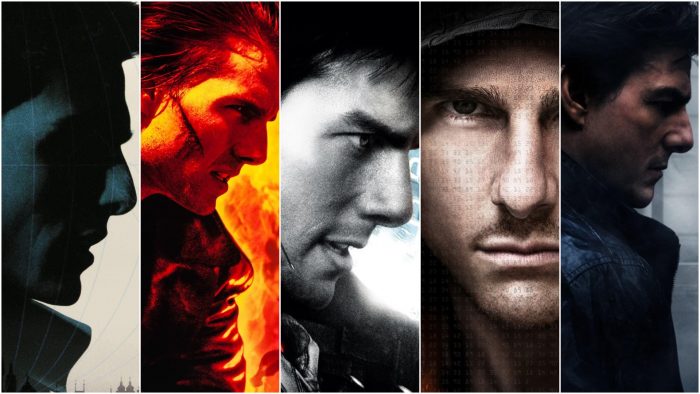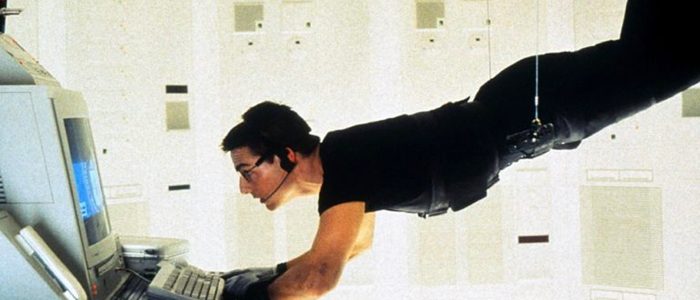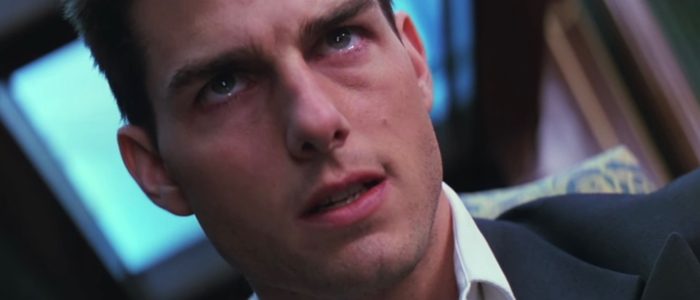Road to ‘Fallout’: How ‘Mission: Impossible’ Became the Best Modern Action Franchise
Talk about impossible: somehow, Mission: Impossible has blossomed into the best modern-day action franchise. Since 1996, Tom Cruise has been inviting audiences along as he defies the odds, risks his life, runs like hell, and delivers increasingly entertaining adventures. Unlike most franchises, Mission: Impossible has generally improved with each subsequent entry. Now, Mission: Impossible – Fallout is ready to draw us in once again.
Before the film arrives, we’ve decided to accept the most dangerous mission of all: a journey through the entire Mission: Impossible franchise in an attempt to learn what makes it tick.
Mission: Impossible
The Director
Brian De Palma, ultimate Hitchcock fanboy and the auteur behind Blow Out, Body Double, Scarface, The Untouchables, and more.
The Mission (Should You Choose to Accept It)
After nearly his entire team is killed off and he’s framed for the crime, IMF Agent Ethan Hunt has to scramble to clear his name. To do so, he must break into the CIA and steal the NOC list, which contains the real names of every undercover espionage agent.
The Team
Mission: Impossible is historically a team effort, but the first film throws a whopper of a twist at the audience: almost the entire team is killed in the first half of the narrative. Tom Cruise is our lead: cocky, constantly-grinning agent Ethan Hunt. Jon Voight is the team leader, Jim Phelps. Emmanuelle Béart is Claire Phelps, Jim’s wife.
Later, Ethan recruits Ving Rhames as master hacker Luther Stickell, and Jean Reno as Franz Krieger, who is clearly evil from the get-go.
The original team consists of Kristin Scott Thomas as Sarah Davies; Emilio Estevez as Jack Harmon; and Ingeborga Dapkunaite as Hannah Williams – all of whom die rather gruesomely (especially Estevez) in the first half-hour of the movie.
The Femme Fatale
Emmanuelle Béart’s Claire Phelps is technically the Femme Fatale of the film, but we don’t really know that until the third act, when it’s revealed she was in cahoots with evil Jim Phelps the entire time.
The Villain(s)
Jon Voight’s Jim Phelps, a character who was a good guy in the TV series, turns out to be the bad guy here. Vanessa Redgrave is also on hand as the charming arms dealer Max. She’s kind of a villain, but she seems really nice, so it’s hard to think of her in these terms. And then of course there’s Jean Reno’s Franz Krieger again, who is in league with Jim and has some really cool-looking knives.
The IMF Director
Henry Czerny as Eugene Kittridge, who suspects Ethan of being the traitor who killed his entire team. Czerny is great here – his voice is smooth as silk, and he seems constantly furious. While bigger name actors would eventually play the IMF Directors to come, Czerny’s Kittridge is one of the most memorable.
Crazy Stunt That Could’ve Killed Tom Cruise
There really aren’t any. While the Mission: Impossible franchise has become renowned for its death-defying stunts, the first film is very low on that aspect. The scene where Ethan Hunt dangles from a cable while hacking into the CIA became instantly iconic, eventually parodied and referenced in countless other films and TV shows. But I wouldn’t call it dangerous. I suppose if the cable had snapped Cruise could’ve fallen hard on the ground and got the wind knocked out of him, or broken a bone. But it’s not deadly like future Cruise Mission stunts.
There’s also a moment where Cruise runs from a wall of rushing water, but again, that’s not that life-threatening. The end of the film has Cruise jumping around on a speeding train, but almost all of this was done in studios via green screens and digital effects.
***
It’s a little jarring to compare the start of the Mission: Impossible film franchise to what the series would become. It’s safe to assume most people think of M:I as an action franchise, but the first entry doesn’t quite fit in that mold. Sure, there’s plenty of action in the movie, but Brian De Palma’s Mission: Impossible is more of a paranoia-tinged thriller, like Three Days of the Condor or The Parallax View. This plays to De Palma’s strengths – he can stage thrilling set pieces, but he’s much more interested in intrigue.
De Palma – and the script by David Koepp and Robert Towne – is also interested in shattering expectations. Within the first half hour, Mission: Impossible takes what fans of the original TV series might remember and kills it, literally. The M:I TV show was all about teamwork, and in the opening scenes, De Palma goes ahead and slaughters virtually the entire team.
Only two members survive: young hot shot Ethan Hunt (Tom Cruise), and Emmanuelle Béart’s Claire Phelps, who seems like an innocent babe in the woods but is, of course, hiding a big secret.
This is, first and foremost, a star vehicle for Cruise, and the actor is in full-blown Tom Cruise mode here. Extremely cocky, a devilish grin almost always on his face, and supremely confident in his abilities to do pretty much anything. Cruise is very good at playing this part, but Ethan Hunt isn’t a particularly interesting character when all is said and done. And his character is secondary to the set pieces De Palma is setting up. In fact, when Mission: Impossible went into production, the script wasn’t even finished. De Palma designed action scenes, and the writers were then in charge of trying to find ways to connect these particular scenes together.
This knowledge makes Mission: Impossible all the more impressive, because gosh darn it, the movie works, and works well. There’s no sense of an unfinished script here, or a troubled production. One moment flows into the next with ease, and De Palma’s incredible direction anchors it all. The filmmaker employs all his trademarks: point-of-view shots, split diopter, titled angles, and even a few smatterings of queasy, sexually-tinged violence (or at least as much as he can get away with in a PG-13 movie).
After Hunt’s team is slaughtered, he attempts to find out what the heck is going on while also breaking into the CIA to help out very polite arms dealer Max (Vanessa Redgrave, who seems to be having the time of her life). This gives De Palma the opportunity to stage a thrilling break-in sequence involving costumes, computers, and of course, Cruise dangling from the ceiling like a spider. The stunt looks so quaint and simple compared to the increasingly elaborate stunts the franchise would eventually employ, but it still works like gangbusters. We can feel the tension mount as Cruise struggles to remain silent and still in the high-security CIA computer room. We tense up as a bead of sweat runs down his hilariously unfashionable ‘90s eyeglasses. It’s a treat to watch. (Speaking of hilarious ‘90s stuff, the biggest laugh in the film comes from watching Hunt surf the web, and fire off an email to the impossible email address Job@3:14.)
The biggest flaw in Mission: Impossible is that it’s a bit front-loaded. The opening sequence, in which the team is brutally dispatched one by one, is engrossing to the point of being hypnotic. Ethan’s panic as he tries to piece together the mystery draws us in. And then the big CIA break-in ratchets up the action to the extreme. But the film is only half-over at this point, and there’s a sense De Palma and company don’t quite know where to take things. So they reveal a big twist – Jim Phelps, Ethan’s team leader, is still alive! Rather than keep things a mystery much longer, De Palma then instantly clues us in (via Ethan’s imagination) to the fact that Jim is a mole and responsible for killing the entire team. One can’t help but think that the script should’ve held this info off just a little bit longer, because by revealing it so early, a considerable amount of dramatic weight is sucked out of the film. What follows is a sequence aboard the TGV train that just can’t quite stack up to everything that came before it (even though it’s a hoot to watch Cruise shout “RED LIGHT! GREEN LIGHT!” before mashing together a piece of explosive chewing gum).
By the time Mission: Impossible ends, Ethan Hunt’s name has been cleared and he’s ready for his next mission, should he choose to accept it. But where would the franchise go from here? Would it try to recreate the energy of this first film, or would it mutate into something, much, much different? I’ll tell you in the next section. This message will self-destruct in five seconds.
Continue Reading The Road to Fallout >>
The post Road to ‘Fallout’: How ‘Mission: Impossible’ Became the Best Modern Action Franchise appeared first on /Film.
from /Film https://ift.tt/2L7l6su



No comments: